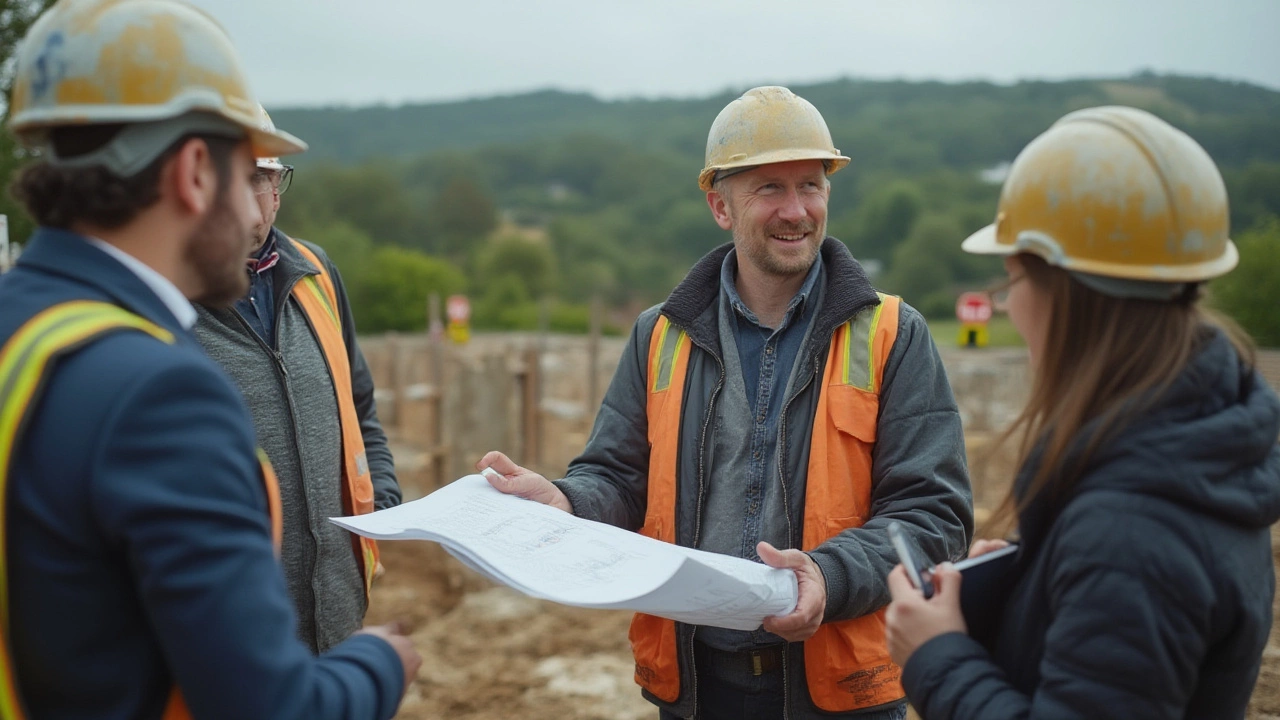Stop for a second and picture a building you love. It could be a glassy skyscraper, a cozy home with an odd-shaped window, or even that punchy new library downtown. Every one of those started as just an idea—chaos tamed by architects. Have you ever wondered what’s really behind the word “architectural services”? It isn’t just drawing pretty buildings. It’s a swirling mix of creativity, practicality, paperwork, and a whole lot of hand-holding from start to finish. What exactly are you getting when you hire an architect? There’s more in that package than most folks realize.
The Full Scope: What’s Included in Architectural Services?
People tend to think architects just hand over blueprints. That’s barely half the story. A licensed architect has their hand on the wheel from those first “what if?” conversations to the last sweep of the construction dust. So, what are you really buying?
- Initial consultation and concept development: Most journeys start with a meeting. Here, architects ask a ton of questions—about your budget, vibe, goals, likes, dislikes, and even stuff you didn’t know you cared about.
- Schematic design: This is where the magic happens on paper. Early sketches and rough plans test different ideas. Want your dining room to face the morning sun? The architect’s already on it.
- Design development: Now the plans get sharper, translating your dream into real walls, windows, and materials. Engineers start joining the conversation. Maybe even a landscape designer or a sustainability consultant.
- Permitting and approvals: Stuck in a maze of rules? Architects wrangle zoning, planning councils, and building code headaches, preparing all the documents for a smooth permit process. In 2023, the American Institute of Architects reported that 68% of clients found permitting more complicated than expected, mostly because rules keep changing. Your architect keeps up.
- Construction documentation: This is the technical backbone—detailed plans, diagrams, and specs so your builder can’t mess it up. Every wire, beam, and faucet fixture has its place.
- Bidding and negotiation: Unless you already have a contractor, your architect rounds up the best candidates, reviews bids, and helps you sort out contracts.
- Construction administration: Architects don’t vanish once the shovels hit dirt. They’ll visit the site, answer the builder’s frantic calls, approve samples, handle change orders, and keep the work on track.
Most architects offer some version of this full package, with options to tackle just one part or manage the whole show. Some even do post-occupancy evaluations—checking how the building performs once people move in, to tweak and improve.
What Architects Actually Do: A Behind-the-Scenes Look
If you shadowed an architect for a week, forget any tidy stereotype. Their days careen between drawing, counseling, troubleshooting, number-crunching, and finding clever ways to squeeze design juice out of strict budgets. Curious about where the architect’s hours really go?
- Client whispering: Whether it’s a family planning their forever home or a school district dreaming up a new campus, architects put energy into listening, translating, and sometimes gently steering wish lists toward what’s really possible.
- Site analysis: Before sketching a single line, architects dig into the plot’s quirks—sun angles, slopes, zoning laws, existing trees, even patterns of neighborhood foot traffic.
- Technology: Digital modeling and Building Information Modeling (BIM) are standard now. These let architects flag conflicts, predict energy use, and save everyone from costly headaches later—including "clash detection" that spots when a pipe would run through a beam.
- Consultant wrangling: Architects coordinate with civil, structural, mechanical, and electrical engineers—and sometimes more exotic consultants too. Ever seen a hospital where door swings crash into beds? That’s what good coordination stops.
- Code knowledge: Architects translate dense city codes so you don’t end up with a windowless basement or illegal stairs. Zoning rules, accessibility (like ADA), fire safety—all checked off before you even break ground.
- Material selection: They don’t just pick what looks nice. Architects weigh lifespan, cost, sustainability, safety, and maintenance.
- Problem-solving: Surprises pop up. Maybe the ground is mushier than anyone guessed, or a rare bird is nesting on your roof. Architecture isn’t just about art—it’s a daily puzzle.
This full-contact involvement is why most clients end up wishing they’d called an architect earlier, not later.

Key Phases of Architectural Services: From Paper to Finished Project
The architectural process plays out in clear phases, each with its distinct flavor. Break it down and the adventure usually looks like this:
- Pre-design/Programming: Way before floorplans, architects dig for facts. How many bedrooms? What’s your favorite time of day? Every need—from pet doors to solar panels—gets logged.
- Schematic Design: Now things get creative. Quick sketches, massing diagrams, test layouts—these all give you options. This phase is where you see the architect’s superpower unleashed: turning a wish list into a buildable idea.
- Design Development: With more focus, the drawings get detailed. You see real room sizes, wall thicknesses, material choices, and can start to really picture yourself inside the space.
- Construction Documentation: Here comes the paperwork. Architects create construction drawings—down to where outlets go, which side doors swing, and how your kitchen cabinets line up. Some firms say this stage eats up 40% or more of the project time.
- Bidding & Negotiation: Time to go shopping for a contractor. Your architect handles the Q&A, reviews contractor references, and negotiates the details so you don’t end up with nasty surprises.
- Construction Administration: As the building rises, the architect keeps a watchful eye—making site visits, approving what gets built, reviewing bills, making sure nobody swaps out your fancy windows for cheap ones.
Below is a table laying out typical project involvement by phase for a standard residential build, adapted from data shared by the Royal Institute of British Architects (RIBA) and the American Institute of Architects (AIA):
| Phase | % of Architect Time | Client Decisions Needed |
|---|---|---|
| Pre-design/Programming | 5-10% | List goals, select site, set budget |
| Schematic Design | 10-15% | Choose layout, clarify style direction |
| Design Development | 15-25% | Confirm materials, early selections |
| Construction Documentation | 30-40% | Approve final plans |
| Bidding & Negotiation | 5-10% | Choose contractor |
| Construction Administration | 15-25% | Approve change orders |
On some projects, you might add phases, like interior design or landscape architecture, or need extra rounds if your city’s permitting office is especially tricky (looking at you, San Francisco!).
Tips for Getting the Most from Your Architect
There’s an old joke: “The biggest check you write in construction isn’t to the builder—it’s for fixing mistakes.” Bringing in an architect early can prevent that nightmarish ending. Want top value from your architectural services? Here’s the truth, straight from folks in the trenches:
- Be brutally honest about your budget: Your architect isn’t judging your wallet—just working to protect it. Overspending often starts with "scope creep" (those tiny wish-list stretches that add up fast).
- Communicate your must-haves (and your ‘heck no’s): Don’t leave them guessing. If you hate open-concept spaces or despise brass fixtures, say so now—before they’re baked in.
- Respond quickly to questions: Design moves fast, but every stalled answer slows the whole train down.
- Ask to see work samples: Not every architect fits every style. Someone who designs killer beach cottages may not be right for your glassy modern build.
- Expect surprise costs: No architect can predict every twist—like finding old fuel tanks buried in your yard. Build a ‘what-if’ cushion of at least 10-15% into your budget.
- Trust your architect’s network: Good architects know reliable engineers, surveyors, and contractors. Use those referrals.
- Don’t skip the site visits: The most beautiful designs sometimes hit a snag in real-world conditions, and it’s usually caught early during a walkthrough with your architect.
- Insist on transparency during construction: You want photos, progress reports, and clear updates. If materials change due to shortages (which has happened a lot since 2021’s supply chain madness), know what’s going in your walls!
- Make sustainability a priority: Ask about energy-efficient options or green certifications. Some programs, like LEED, can bring tax incentives or raise a property’s value.
Plenty of myths swirl around architects. No, they’re not just artists or engineers—they’re serious project managers and code experts too. The best ones listen, ask sharp questions, and safeguard both your dreams and your dollars.
So, what do architectural services include? More than most people ever realize. From dream-stirring sketches to code battles, monster paperwork, and on-site hustle, it’s a full-body experience that leaves you with less stress and a better building. If you want a project to go right, get your architect on board early—and keep them close all the way to the front door.
